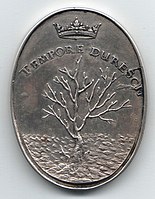Wenceslaus Eusebius of Lobkowicz

Prince Wenzel Eusebius von Lobkowicz ( Czech Václav Eusebius z Lobkovic ) (born January 30, 1609 , † April 22, 1677 in Raudnitz ) was a Bohemian nobleman and diplomat and from 1646 Duke of Sagan .
Life
The scion of the old Bohemian noble family of Lobkowicz and son of the highest chancellor of Bohemia Zdeněk Vojtěch Popel von Lobkowicz and his wife Polyxena was a passionate advocate of Catholic teaching. By clever tactics, he succeeded in amassing a considerable fortune for the Raudnitzer branch of the family.
After thorough training, he joined the imperial army in 1631, but then made a name for himself as a politician and diplomat. His possessions in the Upper Palatinate were in 1641 by Emperor Ferdinand III. raised to the prince-elite county of Störnstein ; as a result, he received on June 30, 1653 seat and vote in the Imperial Council of Prince . In 1646 he acquired the Silesian Duchy of Sagan, which had been confiscated by Emperor Ferdinand II in 1634 after the assassination of the imperial general Albrecht von Wallenstein . From 1670 he had the Baroque Sagan Castle, which is still preserved today, built there by Antonio della Porta . As early as 1652 he had the Bohemian Raudnitz Castle (Roudnice) built as a Baroque palace instead of an older castle, which - with interruptions - still belongs to his descendants today.
He became a confidante of Emperor Leopold I (1640–1705), who appointed him President of the Court War Council in 1657. Later he even rose to the position of Chief Steward of the Privy Council (First Minister). As the first minister, he had unlimited power and control. Although his parents, especially his mother, were supporters of the Spanish crown, Wenzel von Lobkowitz sought out his allies at the French court and thereby created enemies among the Spanish supporters at the Viennese court. On their intervention he fell out of favor with the emperor. On October 16, 1674, the emperor relieved Lobkowitz of his office, had his money and securities confiscated and banished him to his property in Raudnitz without a public trial for high treason. An imperial commission of inquiry is said to have established that Lobkowitz is said to have asked the Archbishop of Mainz on behalf of the French in 1673 to prevent the imperial troops from crossing the Rhine and probably also passed on secret letters from Emperor Leopold I to the French. Avoiding a trial is to be seen as an act of grace on the part of the emperor, since in addition to the public exposure of one of the highest imperial officials, a death sentence for high treason would have been expected.
Marriages and offspring
Wenzel Eusebius married his first marriage on November 3, 1638 Johana Myšková ze Žlunic (1600–1650). The marriage remained childless.
His second wife was Auguste Sophie (1624–1682), daughter of the Count Palatine and Duke August von Sulzbach on February 6, 1653 , with whom he had the following children:
- Son (* / † 1654)
- Ferdinand August (1655–1715), Prince of Lobkowicz, Duke of Sagan
- ⚭ 1. 1677 Countess Claudia von Nassau-Hadamar (1660–1680)
- ⚭ 2. 1680 Princess Anna Maria of Baden-Baden (1655–1701)
- ⚭ 3. 1703 Countess Marie Philippine von Althann (1671–1706)
- ⚭ 4. 1707 Princess Maria Johanna von Schwarzenberg (1681–1739)
- Philipp Ferdinand Adalbert (1656-1659)
- Marie Hedwig Sophie (1658–1660)
- Franz Wilhelm (1659–1698)
Roudnice Castle , Bohemia
Sagan Castle , Silesia
literature
- Constantin von Wurzbach : Lobkowitz, Wenzel Franz Euseb Fürst . In: Biographisches Lexikon des Kaiserthums Oesterreich . 15th part. Imperial and Royal Court and State Printing Office, Vienna 1866, pp. 330–335 ( digitized version ).
- Adam Wolf: Prince Wenzel Lobkowitz, first secret advice from Emperor Leopold I 1609–1677. His life and work . Braumüller, Vienna 1869.
- Adam Wolf : Wenzel Eusebius v. Lobkowitz . In: Allgemeine Deutsche Biographie (ADB). Volume 19, Duncker & Humblot, Leipzig 1884, p. 52.
- Gerhard Seewann : Lobkowitz, Wenzel Eusebius . In: Biographical Lexicon on the History of Southeast Europe . Volume 3. Munich 1979, p. 41 f.
- Hans Schmidt: Lobkowitz, Wenzel Eusebius Prince. In: New German Biography (NDB). Volume 14, Duncker & Humblot, Berlin 1985, ISBN 3-428-00195-8 , p. 732 f. ( Digitized version ).
- Georg Schreiber: Raimondo Montecuccoli. General, writer and gentleman. A picture of life from the baroque era . Styria, Graz, Vienna, Cologne 2000, p. 249 f.
Web links
- Entry on Wenzel Eusebius von Lobkowicz in the Austria Forum (in the AEIOU Austria Lexicon )
Individual evidence
- ↑ Wilhelm Brenner-Schäffer: History and topography of the city of Neustadt an der Waldnab, and his rule of the former lordly county of Störnstein. Negotiations of the historical association of Upper Palatinate and Regensburg, Volume 24, 1866, p. 56.
| personal data | |
|---|---|
| SURNAME | Lobkowicz, Wenzel Eusebius von |
| ALTERNATIVE NAMES | Václav Eusebius z Lobkovic |
| BRIEF DESCRIPTION | Bohemian nobleman, president of the court council |
| DATE OF BIRTH | January 30, 1609 |
| DATE OF DEATH | April 22, 1677 |
| Place of death | Roudnice nad Labem |




